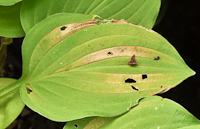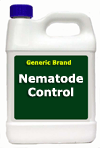When most people hear the
word "nematode" they think of the common root knot
nematode that works beneath the soil line. However, an
increasingly common pest in the landscape are nematodes
that feed in the foliage.
Generally, they belong to
the genus, Aphelenchoides, which infest about 200
host plants. Some of the most common hosts include
Japanese anemone,
begonia,
chrysanthemum,
strawberry,
hosta,
iris,
phlox,
verbena,
zinnia,
dianthus,
impatiens, ferns,
trillium and
African violet.
 Symptoms:
By far, the most common sign of the presence of foliar
nematodes is the browning of the area between the leaf
veins later in the growing season. The damage starts
with linear striping along the veins. Later, these areas
turn to a water soaked appearance eventually turning to
dead, brown tissue.
Symptoms:
By far, the most common sign of the presence of foliar
nematodes is the browning of the area between the leaf
veins later in the growing season. The damage starts
with linear striping along the veins. Later, these areas
turn to a water soaked appearance eventually turning to
dead, brown tissue.
More difficult to detect
signs would be a lack of vigor in the plant, lack of
flowering, stunting and, rarely, death of the plant.
Newly emerged, late season leaves may appear symptom
free.
Life Cycle: Foliar nematodes generally overwinter
in the crown of the plant, on dormant buds or,
sometimes, on leftover debris. The nematodes can swim
around the plant or from plant to plant on surface
water. They are spread in splashing water, from plant
leaves in contact with each other or through contact
with pruning tools and during propagation.
Managing Foliar Nematodes: Foliar nematodes are
not easy to control or eliminate once they are in the
garden. However, certain preventative steps may help to
manage the problem.
-
 Sanitation
- If you find foliar nematodes in your garden,
remove the infested plants and dispose of them
away from the garden. Do not put them in the
compost pile! Also, if you have the problem,
take care to sterilize pruners and other
equipment used on the infested plants. You can
use a one part bleach to nine part water
solution.
Sanitation
- If you find foliar nematodes in your garden,
remove the infested plants and dispose of them
away from the garden. Do not put them in the
compost pile! Also, if you have the problem,
take care to sterilize pruners and other
equipment used on the infested plants. You can
use a one part bleach to nine part water
solution.
Some people have had success using heat to
eliminate foliar nematodes from especially
valuable plants. This involves placing the
dormant crowns in water at 120 degrees F for 15
minutes. If the water is too hot, it may damage
or kill the plant. If it is not warm enough, it
will be ineffective.
-
Use Disease Free Plants
- Nurseries that sell plants such as Hostas that
are known to host nematodes should be careful to
sell only nematode free plants. Also, take care
in accepting gift plants or buying plants at a
neighborhood sale that have not been inspected
for nematodes.
-
Resistance - It
appears that some cultivars of
chyrsanthemums
are resistant to foliar nematodes.
Unfortunately, such resistance has not yet been
found in other susceptible host species.
-
 Pesticides
- At this time, the handful of nematicides that
are effective in treating foliar nematodes are
only available to licensed, commercial
applicators. There are currently no nematicides
labeled for home use against foliar nematodes.
Pesticides
- At this time, the handful of nematicides that
are effective in treating foliar nematodes are
only available to licensed, commercial
applicators. There are currently no nematicides
labeled for home use against foliar nematodes.



